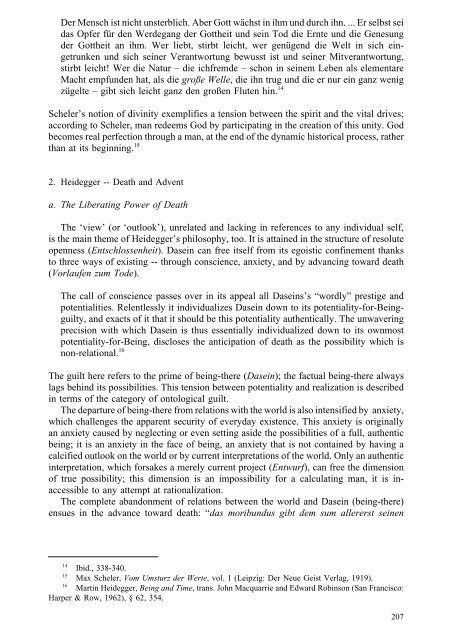[Andrzej_Wiercinski_(ed ... - WordPress.com
[Andrzej_Wiercinski_(ed ... - WordPress.com
[Andrzej_Wiercinski_(ed ... - WordPress.com
You also want an ePaper? Increase the reach of your titles
YUMPU automatically turns print PDFs into web optimized ePapers that Google loves.
Der Mensch ist nicht unsterblich. Aber Gott wächst in ihm und durch ihn. ... Er selbst seidas Opfer für den Werdegang der Gottheit und sein Tod die Ernte und die Genesungder Gottheit an ihm. Wer liebt, stirbt leicht, wer genügend die Welt in sich eingetrunkenund sich seiner Verantwortung bewusst ist und seiner Mitverantwortung,stirbt leicht! Wer die Natur – die ichfremde – schon in seinem Leben als elementareMacht empfunden hat, als die große Welle, die ihn trug und die er nur ein ganz wenigzügelte – gibt sich leicht ganz den großen Fluten hin. 14Scheler’s notion of divinity exemplifies a tension between the spirit and the vital drives;according to Scheler, man r<strong>ed</strong>eems God by participating in the creation of this unity. Godbe<strong>com</strong>es real perfection through a man, at the end of the dynamic historical process, ratherthan at its beginning. 152. Heidegger -- Death and Adventa. The Liberating Power of DeathThe ‘view’ (or ‘outlook’), unrelat<strong>ed</strong> and lacking in references to any individual self,is the main theme of Heidegger’s philosophy, too. It is attain<strong>ed</strong> in the structure of resoluteopenness (Entschlossenheit). Dasein can free itself from its egoistic confinement thanksto three ways of existing -- through conscience, anxiety, and by advancing toward death(Vorlaufen zum Tode).The call of conscience passes over in its appeal all Daseins’s “wordly” prestige andpotentialities. Relentlessly it individualizes Dasein down to its potentiality-for-Beingguilty,and exacts of it that it should be this potentiality authentically. The unwaveringprecision with which Dasein is thus essentially individualiz<strong>ed</strong> down to its ownmostpotentiality-for-Being, discloses the anticipation of death as the possibility which isnon-relational. 16The guilt here refers to the prime of being-there (Dasein); the factual being-there alwayslags behind its possibilities. This tension between potentiality and realization is describ<strong>ed</strong>in terms of the category of ontological guilt.The departure of being-there from relations with the world is also intensifi<strong>ed</strong> by anxiety,which challenges the apparent security of everyday existence. This anxiety is originallyan anxiety caus<strong>ed</strong> by neglecting or even setting aside the possibilities of a full, authenticbeing; it is an anxiety in the face of being, an anxiety that is not contain<strong>ed</strong> by having acalcifi<strong>ed</strong> outlook on the world or by current interpretations of the world. Only an authenticinterpretation, which forsakes a merely current project (Entwurf), can free the dimensionof true possibility; this dimension is an impossibility for a calculating man, it is inaccessibleto any attempt at rationalization.The <strong>com</strong>plete abandonment of relations between the world and Dasein (being-there)ensues in the advance toward death: “das moribundus gibt dem sum allererst seinen14Ibid., 338-340.15Max Scheler, Vom Umsturz der Werte, vol. 1 (Leipzig: Der Neue Geist Verlag, 1919).16Martin Heidegger, Being and Time, trans. John Macquarrie and Edward Robinson (San Francisco:Harper & Row, 1962), § 62, 354.207


